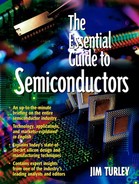Etching Bath
Now that the entire wafer has been exposed with dozens of images of our little chip, it's time to use a little chemical wizardry to start cutting away the parts we don't want. If we bathe our wafer in a bath of just the right chemicals, all the soft parts of the photoresist (the parts that weren't exposed to light) will wash away, along with the insulating chemicals that were underneath. The hardened areas of photoresist, however, will protect the insulating material beneath them.
We've photographically carved away part of our layer cake, leaving tiny valleys in exactly the places we want. It's as if we'd taken a very sharp knife and carefully sliced away some parts of the chip, although no surgeon's scalpel is sharp enough (and no hands steady enough) to do this manually (see Figure 4.8). Even robots could not be made skillful enough. Ever since the first days of semiconductor manufacturing, chips have always been made using this photographic process.
Figure 4.8. After the silicon chip and its layers of extra material have been exposed, etched, and washed some material will remain on top, making three-dimensional wires. This process is repeated several times to make interlocking wires several stories high.

This cycle of depositing chemicals, covering the wafer with photoresist, exposing it to light through our film mask, and etching away the unexposed parts gets repeated more than a dozen times. Over and over, we'll build up layers of material in elaborate three-dimensional constructions to create the transistors that make up our chip.
